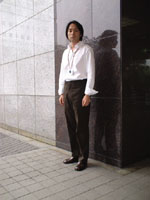The Pulse
Back to Contents of Issue: September 2003
|
|
|
|
|
|
|
UNTIL RECENTLY, WE REALLY didn't have a name for guys who seem unnaturally concerned about their clothing, hair and shoes. Too much fashion sense and style seemed, well, feminine and unmanly. Metrosexuals, straight guys who love their clothes almost as much as their girlfriends, are a growing economic trend that is leaving the high-end luxury market salivating. And nowhere is this truer than in Japan.
Japan has long been a land addicted to high fashion. Japanese girls and office ladies form lines around new luxury stores, waiting hours to be among the first inside. And although Japanese men have for decades not thought twice about carrying a Louis Vuitton handbag, it's only recently that men are dedicating themselves to the gods of high fashion.
Although Naruoka likes his company One glaring example of this trend is the Tuesday night Fuji Television show, "Junk Sports." A regular segment on the show, "Narita Collection," shows clips of famous Japanese sports stars walking from their arrival gate at Narita Airport to their waiting cars. Their attire is analyzed from head to toe, with emphasis on brands and prices. The total cost of their wardrobe and accessories is then meticulously calculated, and it often surpasses JPY1 million. One has to wonder if the stars wore their outfits throughout their entire transoceanic flights, or if they just quickly changed before landing in order to make an appearance on the show.
So what effect could this trend have on the average Japanese salaryman? Masayoshi Naruoka, a 30-year-old former Tokyoite who works for a foreign affiliated medical company in Osaka, provides some clues. If he, an ardent believer in the power of brand goods, is any indication, some very happy days lie ahead for the entire Japanese luxury goods industry.
Naruoka's company recently switched from casual Fridays to an everyday casual dress code -- a rarity in Japan. But this doesn't stop him from dressing well. On any given day, the price of his own "Narita Collection" can rise to six digits.
Since he was in high school, Naruoka has used shampoo that he says is specially formulated for his particular type of hair. Each 2-liter bottle goes for a cool JPY16,000. JPY2,000 eyebrow trimmings are part of the self-grooming treatment each time he gets his hair cut. He's not embarrassed about approaching the Clinique for Men's counter at a department store. "I don't hesitate," he says. Once there, he stocks up on moisturizers, lotions and specialized shaving creams.
To the untrained eye, Naruoka's casual clothes look similar to something sold in Uniqlo. But Naruoka laughs when asked about the discount store. "I won't buy Uniqlo clothes ever," he says dismissively. What about Marutomi, another of Japan's discount retailers? "Never heard of 'em," he claims.
So, how exactly does he choose which brands will make the cut? For many Japanese, nothing beats personal endorsements from celebrities. "Many Japanese young men will select the brand (that) popular people such as talento or sports stars use. People like Hidetoshi Nakata, the very popular soccer player."
Perhaps the most telling sign of the change afoot in the Japanese psyche is the way Naruoka treats his company ID badge. For years, Japanese salarymen have been identified by the small company logo lapel pin they wear on their suits. Naruoka's company requires employees to wear a company ID badge around their necks. The company supplied a free strap emblazoned with the company logo, but Naruoka balked. Although he likes his company and is happy to wear his ID around his neck, the strap doesn't quite go with his JPY36,000 sunglasses. "Our company gave me a strap, but I don't think it is stylish. I can't go outside wearing our company's strap." His solution? A JPY10,000 Armani leather strap for his ID badge.
Anyone hoping to profit from this men's fashion trend might consider looking at importing. Naruoka has made two trips to Italy specifically because luxury items there are available for at least half-price. Clinique shaving cream, which he buys for JPY3,500 at a Japanese department store, is something he hoards when he goes to the US. "I can buy the same shaving cream for $5 or $7 in America."
Casual Dress for a Japanese Metrosexual
-- Mark McCracken
WHILE COUNTRIES SUCH AS France welcomed 75 million visitors in 2001, and the US receives almost 10 times more tourists than Japan, this nation, although rich in culture and diverse natural beauty, needs solutions -- fast. Many foreign tourists are put off by Japan's reputation as the world's most expensive country, while others stay away due to the cultural hurdles involved in daily life.
Prices in Japan are a huge factor. As David from Canada explains: "I think probably the biggest reason I would not want to go to Japan as a tourist is because of the cost. You can often find package tours and cheap flights to Europe and such, but going to Japan is seriously pricey." One of the reasons costs are so high is the complex supply structure in the Japanese distribution "food chain." Many distribution companies handle the product on the way from the manufacturer to the retailer, each taking their commission, thereby bumping up the retail price.
The government realizes there are problems and claims to be seeking solutions. A recent government report states: "Japan has not yet become a country that is sufficiently open to the world in terms of the situation concerning acceptance of foreign tourists as well as domestic foreign direct investment in Japan." One fundamental solution would be an increase in the use of foreign languages in Japan. Zack, a South African visitor, puts it succinctly: "Do the locals honestly expect the typical tourist, being here for merely a few weeks, to learn to order food in Japanese, understand the Japanese train announcements, read museum writing in hiragana and, God forbid, kanji? It makes one think." A tourist from France adds: "A lot of my friends are rather scared by restaurants. There is no problem with the food: It is excellent, but the menus? Just one word in romaji would help so much, only to know if you're looking at the beer or sashimi section."
"The biggest problem facing Japan is its image -- or lack of one," says David from the UK. "If you ask the average person back home about Japan, they may say something about sushi, cars, high technology and a few other things they may have caught on TV. But it's very difficult to form a clear image about Japan before you come."
While exotic locations like Hawaii and Fiji have their "tropical island" image, and Europe has an "old-world" ambience, many people don't have a clear idea of what to expect in Japan. Tourism promoters need to market the "Japan experience" by researching why visitors have enjoyed Japan so much and discovering why they visited in the first place. Of course, things needing improvement include slashing road tolls, drastically cutting back on unnecessary construction and the infamous "roads to nowhere," promoting more interesting local attractions, arts and crafts (as opposed to sand, ramen and curry museums), introducing more Internet cafes, relaxing visa regulations, expanding access to overseas funds and boosting the quality of information about Japan on the Internet.
Japan needs a coordinated tourism strategy to incorporate regional tourism requirements into existing plans -- especially if it hopes to win its targeted 10 million visitors. A groundswell of changes is also needed at the social level. While Japanese businesses have successfully integrated into the global economy, the attitudes -- and fears -- of the people have prevented a true embrace of globalization.
-- Jonathon Walsh |
|
Note: The function "email this page" is currently not supported for this page.


 Young Japanese Men Pay Big Bucks for Vanity
Young Japanese Men Pay Big Bucks for Vanity
 Today's Tourists Sound Off
Today's Tourists Sound Off




